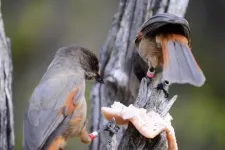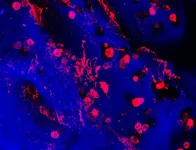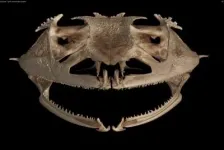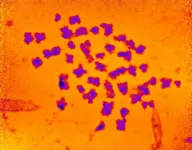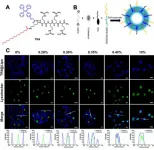(Press-News.org) Siberian jays are group living birds within the corvid family that employ a wide repertoire of calls to warn each other of predators. Sporadically, however, birds use one of these calls to trick their neighbouring conspecifics and gain access to their food. Researchers from the universities of Konstanz (Germany), Wageningen (Netherlands), and Zurich (Switzerland) have now examined how Siberian jays avoid being deceived by their neighbours. The study, published in the journal Science Advances, shows that these birds have great trust in the warning calls from members of their own group, but mainly ignore such calls from conspecifics of neighbouring territories. Thus, the birds use social information to differentiate between trustworthy and presumably false warning calls. Similar mechanisms could have played a role in the formation of human language diversity and especially in the formation of dialects.
Deception and lies
Deception and lies are surprising aspects of human communication and the use of language in which false information is intentionally communicated to others, allowing an individual to gain an advantage over the recipient of such false information. However, language is actually highly pro-social and cooperative and is mainly used to share reliable information. Thus, language can only function properly and be maintained if deception is kept to a minimum or other mechanisms are in place to recognize and avoid deception.
People do judge the reliability of communication partners based on personal experience. "If someone repeatedly lies to you, you will most likely stop trusting this person very quickly," says Dr Michael Griesser, a biologist at the University of Konstanz. Griesser authored the study together with Dr Filipe Cunha, whose doctoral thesis he supervised. But do we observe deception in animals as well, and, if so, which mechanisms do animals use to avoid being deceived?
Warning calls of the Siberian jay
Indeed, a number of species are able to deceive their conspecifics, including some species of primates and birds like the Siberian jay (Perisoreus infaustus). Siberian jays live in territorial groups and have an elaborate communication system: A wide range of calls allow them to warn each other of the presence of different predators as well as the behaviour of their fiercest enemy, the hawk.
Occasionally, however, neighbours intruding into a group's territory use the same calls that would otherwise indicate the presence of a perched hawk for a different purpose. Their aim is to deceive the members of the group about the presence of the predator, thus scaring them away to get access to their food. "It is a commonly observed phenomenon in the animal kingdom that warning calls are used to deceive others. Clearly, the recipients of the false information potentially pay a high price if they ignore the warning," says Cunha.
Only trust those you know?
To find out how Siberian jays identify and respond to this type of deception, the researchers examined a population of wild Siberian jays in northern Sweden. They attracted experienced individuals to a feeding site and recorded video footage of what happened. As soon as such an experienced individual visited the feeder, a loudspeaker played recordings of Siberian jays' warning calls designating a perched hawk. These calls were recordings from former members of the visitor's own group, birds from neighbouring territories, or birds that the visitor had never encountered before. Using the video recordings, the researchers measured how long it took the visitor to leave and return to the feeder.
These "playback experiments" demonstrated that experienced Siberian jays responded quicker and took longer to return to the feeder when hearing warning calls of a former member of their own group than when exposed to warning calls of neighbouring groups or previously unknown individuals. "Siberian jays thus have a simple rule to avoid being tricked: They only trust the warning calls from members of their own group, meaning cooperation partners. Familiarity alone is not enough, otherwise the birds would also have trusted the calls of their neighbours," Griesser explains.
Deception as a possible factor in language and dialect formation
Michael Griesser draws a comparison to humans and their languages and dialects. Just like Siberian jays, humans preferentially trust others who belong to the same group as themselves and therefore more likely are cooperation partners. "It could thus very well be the case that vulnerability to deception has been a driver of the rapid diversification of human languages and facilitating the formation of dialects as they allow the identification of local cooperation partners," Griesser considers.
INFORMATION:
Key facts:
Study: Filipe C. R. Cunha, Michael Griesser (2021) Who do you trust? Wild birds use social knowledge to avoid being deceived. Science Advances; DOI: 10.1126/sciadv.aba2862
Siberian jays use social information to avoid being deceived by neighbours. The birds reacted exclusively to the warning calls of cooperation partners from their own group and ignored the warning calls of others.
Similar mechanisms could have played a role in the diversification of human languages and especially in the formation of dialects.
Dr Michael Griesser is an affiliate member of the "Centre for the Advanced Study of Collective Behaviour" and a researcher in the Department of Biology at the University of Konstanz. The study was completed when Griesser worked as a researcher at the University of Zurich.
Funding was provided by the Swiss National Science Foundation, via the EU Framework Programme for Research and Innovation, Horizon 2020, the University of Zurich and the Science Without Borders Programme in Brazil.
Note to editors:
You can download a photo here:
https://cms.uni-konstanz.de/fileadmin/pi/fileserver/2021/vertrauen_bei_rabenvoegeln.jpg
Caption: A pair of Siberian jays foraging in the study population in Swedish Lapland.
Copyright: Michael Griesser
Contact:
University of Konstanz
Communications and Marketing
Phone: + 49 7531 88-3603
Email: kum@uni-konstanz.de
News media reports about scientific failures that do not recognize the self-correcting nature of science can damage public perceptions of trust and confidence in scientific work, according to findings by researchers at the Annenberg Public Policy Center (APPC) of the University of Pennsylvania and the University at Buffalo, the State University of New York.
News stories about science follow several specific narratives, the researchers write in a new study in the journal Public Understanding of Science. One is that science is "in crisis" or "broken," a narrative driven in recent years by reports of unsuccessful efforts to replicate findings in ...
A new miniature 3D model of human bone marrow has been described today in the open-access eLife journal.
The model may help clinicians predict which patients will benefit from a new therapy for blood platelet disorders, such as Inherited Thrombocytopenias - a group of familial disorders that inhibit the production of platelets. It could also enable further study of these disorders and give scientists a new tool to test experimental treatments.
Platelets are cells that are necessary for the blood to clot and stop bleeding. Having too few platelets can lead to internal or serious bleeding after surgery or injuries, which is usually treated with therapies that cause clotting. Recent studies have shown that a drug called Eltrombopag increases ...
A college education is estimated to add $1 million to a person's lifetime earning potential, but for some students the path to earning one is riddled with obstacles. That journey is even more difficult for students who have been in the foster care system or experienced homelessness, according to a new study from the University of Georgia.
But the more college administrators and faculty know about these students' problems, the more they can do to ease the burden.
Getting into universities in the first place can frequently be a challenge for students who've had unstable home lives, said David Meyers, co-author of the study.
"Research tells us that every time a student moves from one foster care placement to another, they lose six months of educational ...
In recent months, more than three hundred cases of salmonellosis have occurred in various European countries and Canada, which are linked to each other. In the UK the cases could be partly traced back to frozen breaded poultry meat. The cause was contamination with the bacterium Salmonella Enteritidis, which causes gastrointestinal inflammation. Salmonella is not killed by deep freezing and can remain infectious at temperatures below zero degrees Celsius. The Robert Koch Institute (RKI) and the BfR are monitoring the situation together with the Federal Office of Consumer Protection and Food Safety (BVL). In Germany, the number of reported cases has currently ...
GAINESVILLE, Fla. --- Scientists have long known that frogs are oddballs when it comes to teeth. Some have tiny teeth on their upper jaws and the roof of their mouths while others sport fanglike structures. Some species are completely toothless. And only one frog, out of the more-than 7,000 species, has true teeth on both upper and lower jaws.
Now, the first comprehensive study of tooth evolution in frogs is bringing the group's dental history into focus. Florida Museum of Natural History researchers analyzed CT scans of nearly every living amphibian genus to reveal that frogs have lost teeth over 20 times during their evolution, more than any ...
DANVILLE, Pa. - Among people who have strokes and COVID-19, there is a higher incidence of severe stroke as well as stroke in younger people, according to new data from a multinational study group on COVID-19 and stroke, led by a team of Geisinger researchers.
The COVID-19 Stroke Study Group's latest report, published in the journal END ...
LAWRENCE -- In the early days of COVID-19 vaccine development, a new social media platform provided a place for like-minded people to discuss vaccines, share misinformation and speculate about the motivations for its development. A new study from the University of Kansas shows people flocked to Parler to discuss the vaccines in an echo chamber-type environment, and those conversations can shed light about how to communicate about vaccine efficacy during health crises.
COVID-19 vaccine vial and syringe photo from the U.S. Census Bureau.In the runup to the 2020 election, then-president Donald Trump claimed a COVID-19 vaccine could be ready before ...
Mass of human chromosomes measured for the first time
The mass of human chromosomes, which contain the instructions for life in nearly every cell of our bodies, has been measured with X-rays for the first time in a new study led by UCL researchers.
For the study, published in Chromosome Research, researchers used a powerful X-ray beam at the UK's national synchrotron facility, Diamond Light Source, to determine the number of electrons in a spread of 46 chromosomes which they used to calculate mass.
They found that the chromosomes were about 20 times ...
Scientists have revealed a potential mechanism for how traumatic brain injury leads to neurodegenerative diseases, according to a study in fruit flies, and rat and human brain tissue, published today in eLife.
The results could aid the development of treatments that halt the progression of cell damage after brain injury, which can otherwise lead to neurological diseases such as amyotrophic lateral sclerosis (ALS), and Alzheimer's and Parkinson's disease.
Repeated head trauma is linked to a progressive neurodegenerative syndrome called chronic ...
Since the introduction on the market in 1995 of Doxil, pegylated liposomal doxorubicin, liposomes have become one of the most clinically established drug delivery systems in nanomedicine. Among different liposomal formulations, cationic liposomes have attracted great attention because of their capacity to bind negatively charged nucleic acids to perform as non-viral gene delivery tools, and due to their potentials to fuse with cell membranes leading to a direct release of cargoes from liposomes into the cytoplasm and high drug delivery efficiency. However, in most cases, the drug/gene delivery and therapeutic efficacy by cationic liposomes are evaluated ...
